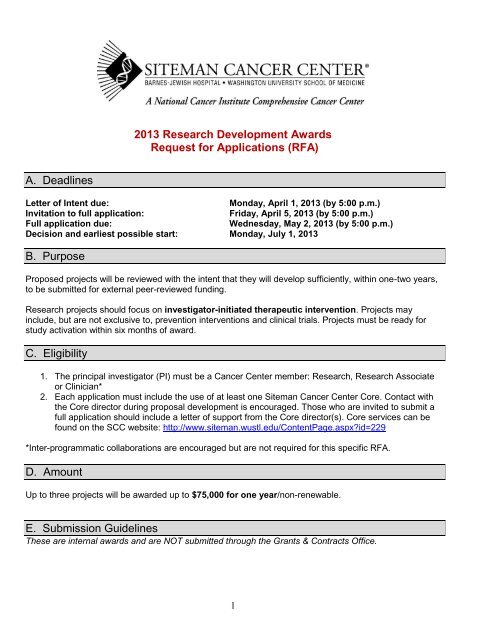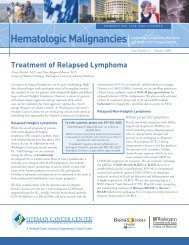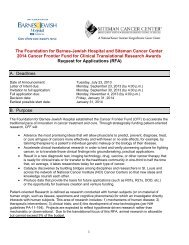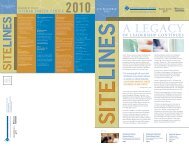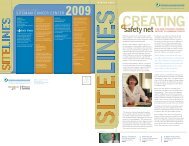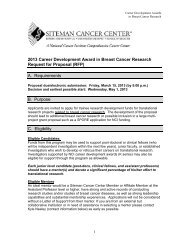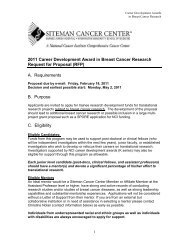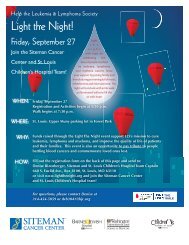2013 Research Development Awards Request for Applications (RFA ...
2013 Research Development Awards Request for Applications (RFA ...
2013 Research Development Awards Request for Applications (RFA ...
You also want an ePaper? Increase the reach of your titles
YUMPU automatically turns print PDFs into web optimized ePapers that Google loves.
<strong>2013</strong> <strong>Research</strong> <strong>Development</strong> <strong>Awards</strong><strong>Request</strong> <strong>for</strong> <strong>Applications</strong> (<strong>RFA</strong>)A. DeadlinesLetter of Intent due:Monday, April 1, <strong>2013</strong> (by 5:00 p.m.)Invitation to full application:Friday, April 5, <strong>2013</strong> (by 5:00 p.m.)Full application due:Wednesday, May 2, <strong>2013</strong> (by 5:00 p.m.)Decision and earliest possible start: Monday, July 1, <strong>2013</strong>B. PurposeProposed projects will be reviewed with the intent that they will develop sufficiently, within one-two years,to be submitted <strong>for</strong> external peer-reviewed funding.<strong>Research</strong> projects should focus on investigator-initiated therapeutic intervention. Projects mayinclude, but are not exclusive to, prevention interventions and clinical trials. Projects must be ready <strong>for</strong>study activation within six months of award.C. Eligibility1. The principal investigator (PI) must be a Cancer Center member: <strong>Research</strong>, <strong>Research</strong> Associateor Clinician*2. Each application must include the use of at least one Siteman Cancer Center Core. Contact withthe Core director during proposal development is encouraged. Those who are invited to submit afull application should include a letter of support from the Core director(s). Core services can befound on the SCC website: http://www.siteman.wustl.edu/ContentPage.aspx?id=229*Inter-programmatic collaborations are encouraged but are not required <strong>for</strong> this specific <strong>RFA</strong>.D. AmountUp to three projects will be awarded up to $75,000 <strong>for</strong> one year/non-renewable.E. Submission GuidelinesThese are internal awards and are NOT submitted through the Grants & Contracts Office.1
Step 1: Letter of Intent (LOI): A letter of intent is required in order to be invited to submit a fullapplication. Forms are also available on the SCC website:http://www.siteman.wustl.edu/fundingopportunities.aspxa) Letter of Intent Cover Sheet (link to download)b) Letter of Intent Form (link to download)Email completed <strong>for</strong>ms by the deadline, April 1, <strong>2013</strong>, to Paige Isom at isomp@wudosis.wustl.edu.Step 2: Full application: Upon notification that the LOI has been approved, combine all sections notedbelow into one PDF document and email your submission by the deadline, May 2, <strong>2013</strong>, to Paige Isom atisomp@wudosis.wustl.edu.Required documents: All documents are required to be on the NIH PHS 398 <strong>for</strong>ms unless otherwisenoted. All <strong>for</strong>ms can be found at: http://grants.nih.gov/grants/funding/phs398/phs398.html#fp1Please type your name (last name, first initial) in the header of each page. Use Arial 11 point font<strong>for</strong> all text.1. Face Page (PHS 398 Form Page 1: Face Page)2. Project Summary and Key Personnel (PHS 398 Form Page 2)3. Budget (PHS 398 Form Page 4 and 5); Page 5 includes Budget Justification narrative. Usecontinuation page as needed. (See allowable expenditures below)4. NIH Biosketch (Sample provided on PHS 398 <strong>for</strong>ms page) Please use NIH guidelines;biosketches are required <strong>for</strong> all key personnel5. <strong>Research</strong> Plan (PHS 398 continuation pages: up to 5 pages)The following headings should be used <strong>for</strong> the research plan.A. Specific Aims (1/2 page maximum): State concisely the hypothesis to be tested and the specificaim(s) to be achieved during the grant period. The aims must be reasonable to achieve during aone-year period.B. Significance (1/2 page maximum): Explain the importance of the problem or critical barrier toprogress in the field that the proposed project addresses. Describe how the proposed project willimprove scientific knowledge, technical capability, and or clinical practice and describe thepotential impact this research will have on cancer morbidity and/or mortality.C. Background and Preliminary Investigations (1-1.5 pages maximum): Discuss the pertinentresearch findings that have been described in the scientific literature and how this proposal willadd to these results. Also discuss any preliminary data obtained that are relevant to this proposal.D. Experimental Design and Methods (1-1.5 pages maximum): Concisely present the experimentaldesign and the methods to be used to accomplish the specific aims. Also indicate how the resultswill be interpreted and how they will lead to future investigations. Well-known methods andstandard procedures may be described very briefly or referenced, but novel experimentalapproaches should be outlined in more detail.E. Plans <strong>for</strong> Subsequent Funding (1/2 page maximum): Describe plans <strong>for</strong> future, collaborativeapplications based on the proposed work.6. Literature Cited – maximum 1 page (PHS 398 continuation pages)7. <strong>Applications</strong> must include protocol and consent <strong>for</strong>ms (drafts acceptable).2
8. Letters documenting feasibility: Demonstrations of feasibility will vary based on study focus,design, and specific intervention; examples include letters from (1) the pharmaceutical companyassuring access to the investigational agent; (2) a clinic manager committing to facilitaterecruitment of a specific population; or (3) the department/division confirming collaboration.9. Attach Animal or Human Subjects approvals if needed. All new cancer-related research involvinghuman subjects, needs approval by the Human <strong>Research</strong> Protection Office (HRPO), and mustfirst be reviewed and approved by the Siteman Cancer Center Protocol Review and MonitoringCommittee (PRMC). Funds will not be released prior to PRMC and HRPO approval. Pleaseinclude a page explaining your project’s human participation (from HRPO application), or theanticipated date you will be submitting to the PRMC/HRPO, and when approval is expected.10. Letters of Support: Include a letter of support from the Core director of the core(s) you will beusing in your research. If the project requires a sponsor, consultant or collaborator, this individualshould write a letter of support <strong>for</strong> the application, including an explanation of how any overlap inef<strong>for</strong>t will be reconciled if the project is funded. Junior faculty applicants (instructor or assistantprofessor) are required to submit a letter of support from their Department or Division chair.Expenditures Allowed Salary support <strong>for</strong> the applicant as needed <strong>Research</strong> supplies and animal maintenance (including animal per diem charges) Per diem charges <strong>for</strong> patients if part of a clinical study not reimbursable by standard paymentterms Technical assistance Publication costs, including reprints, study instruments, surveys, etc. Costs of computer time Special fees (pathology, photography, etc.)Expenditures NOT Allowed Secretarial/administrative personnel salary support Office equipment and supplies Computer/equipment maintenance fees Tuition Indirect institutional costs TravelIf you have questions, please contact Paige Isom, isomp@wudosis.wustl.edu , 314-454-8981.F. Terms of the AwardThese funds are <strong>for</strong> one year. It is expected that the grantee will completely utilize the full amountof funding during the one-year term of the award. No-cost extensions of one year may be grantedwith the approval of the RDA Review Committee. <strong>Request</strong>s must be made 30 days prior to theend of the funding period. All unspent funds at the end of the grant period (unless you haverequested and been granted a no-cost extension) will be returned.HRPO & PRMC approvals are not required at the time of submission. However, all awards musthave appropriate institutional regulatory approvals (SCC Protocol Review and MonitoringCommittee, Human <strong>Research</strong> Protection Office, Animal Studies, Radiation Safety) be<strong>for</strong>e fundswill be transferred.A progress report will be required to be submitted no later than 60 days following the end of thefunding period and <strong>for</strong> the following 3-5 years to capture any subsequent grants or publications.3
No Indirect costs will be awarded.G. Review ProcessAll applications will be evaluated by two anonymous reviewers and scored according to scientific meritand accordance with the <strong>RFA</strong> using the NIH guideline <strong>for</strong> scoring. Proposals will be evaluated accordingto the degree to which they:are scientifically novelare investigator-initiated therapeutic interventions,are likely to lead to extramural research support preferably from the NCI, andutilize one or more of the SCC shared resources.Example: If two proposals are of equal scientific merit and only one of the two can be funded, the projectthat involves investigators from more than one program, utilizes more cores, and/or is judged more likelyto lead to extramural funding from the NCI, will be funded.4


